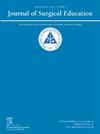Does Learner Communication Behavior Change Based on Context? Observations of Surgical Residents Across Clinical Rotations
IF 2.6
3区 医学
Q1 EDUCATION, SCIENTIFIC DISCIPLINES
引用次数: 0
Abstract
Objective
As surgical residency programs begin developing communication skills-specific training curricula, it is important to understand those skills required of surgeons in the many settings in which they work. It is also useful to observe the skills that residents already demonstrate, as well as those skills that need further development. This study evaluated surgical residents' communication behaviors across different services to understand how the clinical learning environment influences their approach to surgeon-patient interactions.
Design and Setting
Our communication coaching program used standardized observation and coding to evaluate residents’ communication on pediatric surgery, community general surgery, and trauma/acute care surgery services.
Participants
Twenty-four senior residents were observed interacting with patients and families on morning rounds in each of 3 settings.
Results
A total of 373 patient-resident interactions were observed. Behaviors like introducing the team, showing courtesy and respect, and sharing next steps were consistent across settings. However, different patterns emerged when evaluating 15 skills: effective communication behaviors occurred at the highest rates in pediatrics, followed by community surgery, and lowest in trauma. Most communication behaviors varied significantly between settings, underscoring the need to understand effective communication in each context to support learner development accordingly.
Conclusions
Communication skills varied significantly among the same surgical residents across different settings. The findings highlight the importance of supporting learners in adapting fundamental aspects of effective communication in various clinical environments. Modern surgical training can benefit from increased focus on communication skills across learning environments, using 1:1 communication coaching that emphasizes existing strengths, and tailoring communication skills to particular settings.
学习者的交流行为是否会因语境而改变?外科住院医师临床轮转观察。
目的:随着外科住院医师项目开始开发专门的沟通技巧培训课程,了解外科医生在许多工作环境中所需要的技能是很重要的。观察居民已经展示的技能,以及那些需要进一步发展的技能,也很有用。本研究评估了外科住院医师在不同服务中的沟通行为,以了解临床学习环境如何影响他们与外科病人互动的方式。设计与设置:我们的沟通指导项目采用标准化的观察和编码来评估住院医生在儿科外科、社区普外科和创伤/急症护理外科服务方面的沟通情况。参与者:24名老年住院医师在3种情况下与患者和家属进行晨间查房。结果:共观察到373例患者与住院医师的互动。像介绍团队、表现礼貌和尊重、分享下一步等行为在不同环境下是一致的。然而,当评估15种技能时,不同的模式出现了:有效的沟通行为在儿科的发生率最高,其次是社区外科,最低的是创伤。大多数沟通行为在不同的环境中差异很大,这强调了在每种环境中理解有效沟通的必要性,以相应地支持学习者的发展。结论:同一外科住院医师在不同环境下的沟通技巧差异显著。研究结果强调了在各种临床环境中支持学习者适应有效沟通的基本方面的重要性。现代外科培训可以从更多地关注跨学习环境的沟通技巧中受益,使用强调现有优势的1:1沟通指导,并根据特定环境调整沟通技巧。
本文章由计算机程序翻译,如有差异,请以英文原文为准。
求助全文
约1分钟内获得全文
求助全文
来源期刊

Journal of Surgical Education
EDUCATION, SCIENTIFIC DISCIPLINES-SURGERY
CiteScore
5.60
自引率
10.30%
发文量
261
审稿时长
48 days
期刊介绍:
The Journal of Surgical Education (JSE) is dedicated to advancing the field of surgical education through original research. The journal publishes research articles in all surgical disciplines on topics relative to the education of surgical students, residents, and fellows, as well as practicing surgeons. Our readers look to JSE for timely, innovative research findings from the international surgical education community. As the official journal of the Association of Program Directors in Surgery (APDS), JSE publishes the proceedings of the annual APDS meeting held during Surgery Education Week.
 求助内容:
求助内容: 应助结果提醒方式:
应助结果提醒方式:


